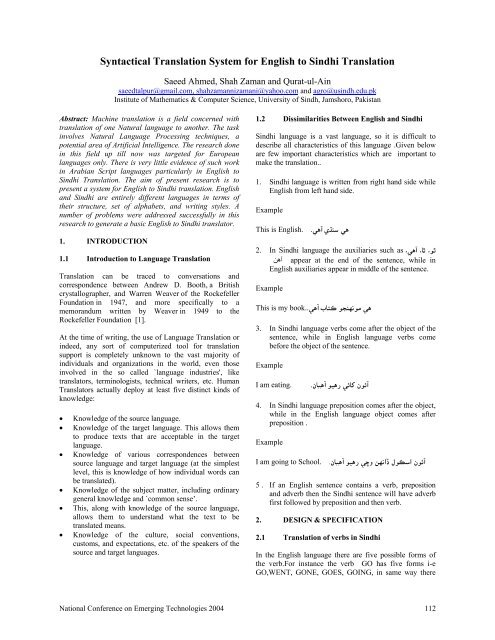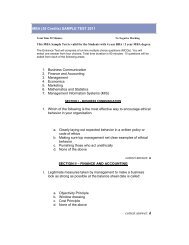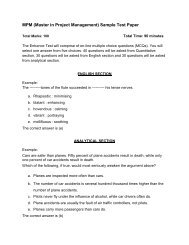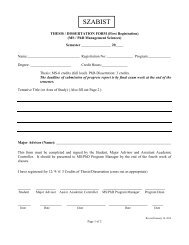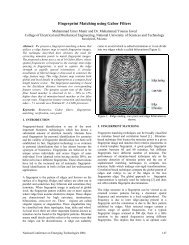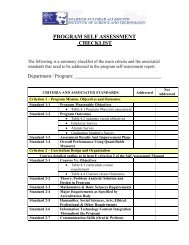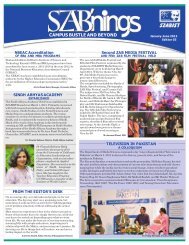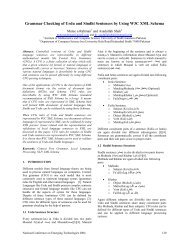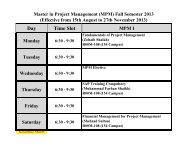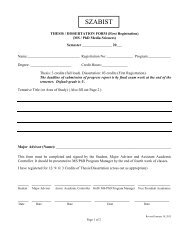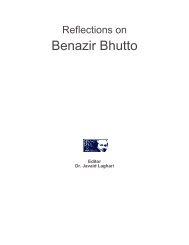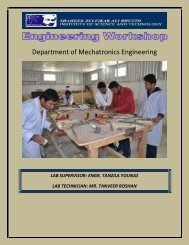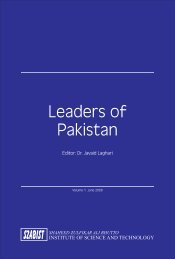Syntactical Translation System for English to Sindhi ... - SZABIST
Syntactical Translation System for English to Sindhi ... - SZABIST
Syntactical Translation System for English to Sindhi ... - SZABIST
Create successful ePaper yourself
Turn your PDF publications into a flip-book with our unique Google optimized e-Paper software.
<strong>Syntactical</strong> <strong>Translation</strong> <strong>System</strong> <strong>for</strong> <strong>English</strong> <strong>to</strong> <strong>Sindhi</strong> <strong>Translation</strong><br />
Saeed Ahmed, Shah Zaman and Qurat-ul-Ain<br />
saeedtalpur@gmail.com, shahzamannizamani@yahoo.com and agro@usindh.edu.pk<br />
Institute of Mathematics & Computer Science, University of Sindh, Jamshoro, Pakistan<br />
Abstract: Machine translation is a field concerned with<br />
translation of one Natural language <strong>to</strong> another. The task<br />
involves Natural Language Processing techniques, a<br />
potential area of Artificial Intelligence. The research done<br />
in this field up till now was targeted <strong>for</strong> European<br />
languages only. There is very little evidence of such work<br />
in Arabian Script languages particularly in <strong>English</strong> <strong>to</strong><br />
<strong>Sindhi</strong> <strong>Translation</strong>. The aim of present research is <strong>to</strong><br />
present a system <strong>for</strong> <strong>English</strong> <strong>to</strong> <strong>Sindhi</strong> translation. <strong>English</strong><br />
and <strong>Sindhi</strong> are entirely different languages in terms of<br />
their structure, set of alphabets, and writing styles. A<br />
number of problems were addressed successfully in this<br />
research <strong>to</strong> generate a basic <strong>English</strong> <strong>to</strong> <strong>Sindhi</strong> transla<strong>to</strong>r.<br />
1. INTRODUCTION<br />
1.1 Introduction <strong>to</strong> Language <strong>Translation</strong><br />
<strong>Translation</strong> can be traced <strong>to</strong> conversations and<br />
correspondence between Andrew D. Booth, a British<br />
crystallographer, and Warren Weaver of the Rockefeller<br />
Foundation in 1947, and more specifically <strong>to</strong> a<br />
memorandum written by Weaver in 1949 <strong>to</strong> the<br />
Rockefeller Foundation [1].<br />
At the time of writing, the use of Language <strong>Translation</strong> or<br />
indeed, any sort of computerized <strong>to</strong>ol <strong>for</strong> translation<br />
support is completely unknown <strong>to</strong> the vast majority of<br />
individuals and organizations in the world, even those<br />
involved in the so called `language industries', like<br />
transla<strong>to</strong>rs, terminologists, technical writers, etc. Human<br />
Transla<strong>to</strong>rs actually deploy at least five distinct kinds of<br />
knowledge:<br />
• Knowledge of the source language.<br />
• Knowledge of the target language. This allows them<br />
<strong>to</strong> produce texts that are acceptable in the target<br />
language.<br />
• Knowledge of various correspondences between<br />
source language and target language (at the simplest<br />
level, this is knowledge of how individual words can<br />
be translated).<br />
• Knowledge of the subject matter, including ordinary<br />
general knowledge and `common sense’.<br />
• This, along with knowledge of the source language,<br />
allows them <strong>to</strong> understand what the text <strong>to</strong> be<br />
translated means.<br />
• Knowledge of the culture, social conventions,<br />
cus<strong>to</strong>ms, and expectations, etc. of the speakers of the<br />
source and target languages.<br />
1.2 Dissimilarities Between <strong>English</strong> and <strong>Sindhi</strong><br />
<strong>Sindhi</strong> language is a vast language, so it is difficult <strong>to</strong><br />
describe all characteristics of this language .Given below<br />
are few important characteristics which are important <strong>to</strong><br />
make the translation..<br />
1. <strong>Sindhi</strong> language is written from right hand side while<br />
<strong>English</strong> from left hand side.<br />
Example<br />
This is <strong>English</strong>.<br />
هي سنڌي آهي .<br />
ٿو، ٿا، آهي، 2. In <strong>Sindhi</strong> language the auxiliaries such as<br />
appear at the end of the sentence, while in آهن<br />
<strong>English</strong> auxiliaries appear in middle of the sentence.<br />
Example<br />
هي مونهنجو كتاب آهي . book. This is my<br />
3. In <strong>Sindhi</strong> language verbs come after the object of the<br />
sentence, while in <strong>English</strong> language verbs come<br />
be<strong>for</strong>e the object of the sentence.<br />
Example<br />
I am eating.<br />
آئون کائي<br />
رهيو آهيان .<br />
4. In <strong>Sindhi</strong> language preposition comes after the object,<br />
while in the <strong>English</strong> language object comes after<br />
preposition .<br />
Example<br />
I am going <strong>to</strong> School.<br />
آئون אسكول ڏאنهن وڇي رهيو آهيان .<br />
5 . If an <strong>English</strong> sentence contains a verb, preposition<br />
and adverb then the <strong>Sindhi</strong> sentence will have adverb<br />
first followed by preposition and then verb.<br />
2. DESIGN & SPECIFICATION<br />
2.1 <strong>Translation</strong> of verbs in <strong>Sindhi</strong><br />
In the <strong>English</strong> language there are five possible <strong>for</strong>ms of<br />
the verb.For instance the verb GO has five <strong>for</strong>ms i-e<br />
GO,WENT, GONE, GOES, GOING, in same way there<br />
National Conference on Emerging Technologies 2004 112
are more then 59 possible <strong>for</strong>ms of verb in the <strong>Sindhi</strong><br />
language [2], [3]. In order <strong>to</strong> make the translation of<br />
sentence from <strong>English</strong> <strong>to</strong> <strong>Sindhi</strong> or vice versa, all possible<br />
meanings of a verb (<strong>for</strong> <strong>Sindhi</strong>) in the database had <strong>to</strong> be<br />
added. In order <strong>to</strong> reduce the size of database a new<br />
methodology is developed. For each verb some letters are<br />
put in the database, and by adding some letters at the end<br />
of these letters, the required meaning of the verb (in <strong>Sindhi</strong>)<br />
can be achieved. Different letters have <strong>to</strong> be added<br />
according <strong>to</strong> different tenses and different <strong>for</strong>ms of verbs,<br />
refer table1, table2 and table 3.<br />
Table 1: Characters required <strong>for</strong> the present simple,<br />
continuous and perfect continuous tenses.<br />
Word I We He She It<br />
Add<br />
ان ون ي ي ي Word You_1 You_2 They F_Name M_Name<br />
Add<br />
ين و ن ي ي Table 2. Characters required <strong>for</strong> the past simple tense.<br />
Word I We He She It<br />
Add<br />
س اسين و ي و Word You_1 You_2 They F_Name M_Name<br />
Add<br />
ن ا ا ي و Table 3. Characters required <strong>for</strong> the present perfect, past<br />
perfect, past continuous and past perfect continuous.<br />
Word I We He She It<br />
Add<br />
و ا و ي و Word You_1 You_2 They F_Name M_Name<br />
Add<br />
و ا ا ي و Secondly the meaning of pronoun is also affected in<br />
<strong>Sindhi</strong> according <strong>to</strong> various situations but they remain<br />
same in <strong>English</strong>.<br />
e.g.<br />
آئون אسكول ويس I went <strong>to</strong> School<br />
مون אنب کاڌو I ate mango<br />
It can be seen that the meaning of I is آئون in first sentence<br />
and مون in the second sentence.<br />
In the remaining tenses it is required <strong>to</strong> observe whether<br />
the subject is singular or plural and the second<br />
consideration is <strong>to</strong> check the gender of the subject.<br />
2.2 Rules <strong>for</strong> <strong>Sindhi</strong> Sentences<br />
One of the important tasks <strong>for</strong> translation was <strong>to</strong> define<br />
structural rules <strong>for</strong> both languages. <strong>English</strong> language rules<br />
were defined by James H. Martin and Davis Jurasky [1],<br />
but there were no rules available <strong>for</strong> <strong>Sindhi</strong> language. A<br />
successful attempt was made in this regard and rules were<br />
defined <strong>for</strong> <strong>Sindhi</strong> language. The current research also<br />
aims <strong>to</strong> define the structure of the <strong>Sindhi</strong> language. In<br />
order <strong>to</strong> make translation, it is required <strong>to</strong> change <strong>English</strong><br />
sentence according <strong>to</strong> the sequence of <strong>Sindhi</strong><br />
sentence.Table 4 contains rules <strong>for</strong> <strong>English</strong> and <strong>Sindhi</strong><br />
sentences .<br />
Table 4. <strong>English</strong> and <strong>Sindhi</strong> sentence rules<br />
<strong>English</strong> Sentence Rules<br />
NP VP<br />
NP AUX VP<br />
WhNP NP AUX VP<br />
WhNP NP VP<br />
WhNP VP<br />
WhNP NP AUX<br />
WhNP VP AUX<br />
WhNP AUX VP<br />
WhNP NP AUX PP<br />
Verb NP<br />
Verb NP PP<br />
Verb NP PP1 PP2<br />
Verb PP<br />
NP PP<br />
Verb Adverb<br />
Verb NP Adverb<br />
<strong>English</strong> Sentence Rules<br />
Verb PP Adverb<br />
Verb NP PP Adverb<br />
Verb NP1 NP2<br />
Verb NP1 NP2 NP3<br />
Verb NP1 NP2 PP<br />
Verb PP1 PP2<br />
Verb PP1 PP2 PP3<br />
Verb PP NP<br />
Verb NP1 PP NP2<br />
Adverb Adjective<br />
<strong>Sindhi</strong> Sentence<br />
Rules<br />
NP VP<br />
NP VP AUX<br />
NP WhNP VP AUX<br />
WhNP NP VP<br />
WhNP VP<br />
NP WhNP AUX<br />
WhNP VP AUX<br />
WhNP AUX VP<br />
PP NP WhNP AUX<br />
NP Verb<br />
NP PP Verb<br />
PP2 PP1 NP Verb<br />
PP Verb<br />
PP NP<br />
Adverb Verb<br />
Adverb NP Verb<br />
<strong>Sindhi</strong> Sentence<br />
Rules<br />
Adverb PP Verb<br />
Adverb PP NP Verb<br />
NP2 NP1 Verb<br />
NP3 NP2 NP1 Verb<br />
PP NP2 NP1 Verb<br />
PP2 PP1 Verb<br />
PP3 PP2 PP1 Verb<br />
NP PP Verb<br />
NP2 PP NP1 Verb<br />
Adjective Adverb<br />
2.3 Degree of Adjectives <strong>for</strong> <strong>Sindhi</strong><br />
The meaning of adjective in <strong>Sindhi</strong> language changes<br />
according <strong>to</strong> the gender of the object. The meaning further<br />
changes according <strong>to</strong> the singularity or plurality of the<br />
object. In order <strong>to</strong> put all the possible meanings a large<br />
database was required. The problem is addressed by<br />
adding some letters at the end of each word <strong>to</strong> complete<br />
the meaning of an adjective according <strong>to</strong> the need of<br />
sentence. These letters are given in table 5.<br />
Table 5. Characters <strong>for</strong> adjectives<br />
Singular<br />
Plural<br />
يون ي Feminine<br />
ا و Masculine<br />
When the object is singular feminine then character ”ي“ is<br />
added and ”و“ when it is singular masculine. When the<br />
object is plural feminine the characters ”يون“ are added,<br />
and character ”ا“ is added when it is plural masculine.<br />
There are three degrees of an adjective base, comparative<br />
and superlative. For instance hard, harder, hardest. For<br />
getting the meaning of all <strong>for</strong>ms of adjective, only the<br />
National Conference on Emerging Technologies 2004 113
meaning of base <strong>for</strong>m of adjective is required. For the<br />
meaning of comparative adjective only “ ڌيכو ” is added<br />
be<strong>for</strong>e the meaning of base <strong>for</strong>m of adjective, and in the<br />
same way by adding word ,تمام“ meaning of superlative<br />
adjective is achieved.<br />
Example Hard Harder Hardest<br />
سخت<br />
وڌيك سخت تمام سخت Big Bigger Biggest<br />
تمام وڏو وڌيك وڏو<br />
وڏو<br />
2.4 <strong>Translation</strong> of Numbers Written in Words<br />
The numbers in <strong>English</strong>, which are written in words, is a<br />
tedious task <strong>to</strong> examine and convert <strong>to</strong> <strong>Sindhi</strong>. An<br />
algorithm is designed <strong>for</strong> this conversion, which nicely<br />
converts even very long numbers in<strong>to</strong> numerical <strong>for</strong>mat,<br />
and then with the help of database, the numerical value is<br />
converted <strong>to</strong> words in <strong>Sindhi</strong>.<br />
Usually, the largest value in <strong>English</strong> is billion. The values<br />
larger then Billion are important <strong>for</strong> scientists and not <strong>for</strong><br />
common man. So billion is supposed <strong>to</strong> be the largest<br />
word used in daily transactions.<br />
The algorithm follows the following steps in order <strong>to</strong><br />
convert a number made up of words in<strong>to</strong> the<br />
corresponding numerical value:<br />
1. Recognize a combination of continues words <strong>to</strong> be a<br />
number from the input collection of words<br />
representing a sentence.<br />
2. Take the first word from the stream. If the word is<br />
one of the following:<br />
“one”, “two”, …, “ninety”, then<br />
i) If the current word is the last word then assign the<br />
word’s value <strong>to</strong> the “temp” variable.<br />
ii) If the current word is not the last one, add the<br />
word’s value <strong>to</strong> the “temp” variable.<br />
3. If the word is “hundred” then<br />
i) If it is the last word in stream, assign the word’s<br />
value <strong>to</strong> the temp variable<br />
ii) Else, multiply the word’s value with the “temp”<br />
variable<br />
4. if the word is “thousand”, “million”, “billion”, …,<br />
then multiply “temp’s” value <strong>to</strong> the word, and put the<br />
value in appropriate variable (“thousand”, “million”,<br />
etc.). Assign the value Zero <strong>to</strong> the “temp” variable<br />
5. Take the next word out from the array of words of the<br />
number, and repeat steps 2 <strong>to</strong> 4 <strong>for</strong> it.<br />
6. Reaching the end, the final numerical value of the<br />
number can be calculated as:<br />
Number = Billion + Million + Thousand<br />
+ temp<br />
In general the algorithm says that, if any word has a value<br />
larger than the previous word, multiply both. Otherwise if<br />
any word has a value smaller than the previous word, add<br />
the word <strong>to</strong> the <strong>to</strong>tal.<br />
After getting the value of the number in words, it is<br />
translated in<strong>to</strong> words in <strong>Sindhi</strong>. This is done by first<br />
dividing the number in<strong>to</strong> its component parts. <strong>Sindhi</strong> has a<br />
unit system different from that of <strong>English</strong>. It uses<br />
multiples of hundred <strong>for</strong> describing the units, in contrast<br />
with <strong>English</strong> that uses multiples of thousand <strong>for</strong> describing<br />
the units. <strong>Sindhi</strong>’s units are given in table 6:<br />
Table 6. Unit system <strong>for</strong> <strong>Sindhi</strong><br />
<strong>English</strong> Value <strong>Sindhi</strong><br />
Hundred 100 Sow<br />
Thousand 1,000 Hazar<br />
Hundred Thousand 1,00,000 Lac<br />
Ten Million 1,00,00,000 Crore<br />
Billion 1,00,00,00,000 Arb<br />
First, the input numerical value is converted in<strong>to</strong> its <strong>Sindhi</strong><br />
component parts. Then with the help of database, the<br />
proper names of units are found from database and values<br />
and then they are put in proper order, <strong>to</strong> get the number in<br />
words of <strong>Sindhi</strong>.<br />
3. CONCLUSION AND FUTURE WORK<br />
A language translation system has been developed on a<br />
very basic level that will help the developers <strong>to</strong> get in the<br />
world of language translation. Researchers have tried <strong>to</strong><br />
cover the three levels of grammar tenses (Present,<br />
Continuous & Past and their four sub tenses (Indefinite,<br />
Continuous, Perfect & Perfect Continuous).<br />
The present research successfully defines rules <strong>for</strong> <strong>Sindhi</strong><br />
language through which structure of <strong>Sindhi</strong> sentence can<br />
be identified.<br />
The translation of sentences that contain the model<br />
auxiliaries, <strong>for</strong> example can, and would and so on is also<br />
achieved.<br />
This project handles the problem of proper noun. It takes<br />
proper nouns and au<strong>to</strong>matically translates them in <strong>Sindhi</strong><br />
word, without the help of database.<br />
The present work in no way can be termed as complete<br />
and fully operational. A number of enhancements and<br />
refinements are possible. During the research more stress<br />
was on functionality there<strong>for</strong>e the database is limited and<br />
should be enhanced in future.<br />
In the process of translation there were many ambiguities,<br />
few of them have been resolved, others still have <strong>to</strong> be<br />
addressed, e.g Semantic rules are not applied; these rules<br />
should be implemented in future in order <strong>to</strong> increase the<br />
accuracy of translation.<br />
The project is not targeted <strong>for</strong> complex sentences and the<br />
sentences that contain idioms. It is recommended <strong>for</strong> the<br />
future researchers <strong>to</strong> work on the complex sentences and<br />
idioms.<br />
National Conference on Emerging Technologies 2004 114
As this project has limited features, so the error detection<br />
from the sentence is not achieved. It is also recommended<br />
<strong>for</strong> the future researchers <strong>to</strong> work over this.<br />
ACKNOWLEDGEMENT<br />
All praises and gratitude <strong>to</strong> Almighty Allah <strong>for</strong> His<br />
Benevolence. After this, we wish <strong>to</strong> express our sincere<br />
appreciation <strong>to</strong> Mr. Aslam Pervaiz Memon <strong>for</strong> his help<br />
and support in this research. The completion of this<br />
research was made possible only by Miss. Qurat-ul-Ain<br />
Agro, and her dedicated and committed supervision. She<br />
was available <strong>to</strong> us at all times solving our problems and<br />
guiding <strong>to</strong> us.<br />
The amount of support and affection from our families is<br />
uncountable. Last but not the least; we would like <strong>to</strong> thank<br />
all faculty members of Institute of Mathematics and<br />
Computer Science, University of Sindh <strong>for</strong> their<br />
Cooperation.<br />
REFERENCES<br />
[1] John Hutchins. In proceedins <strong>to</strong> MT Summit VI: past,<br />
present, future, pp. 14-23. San Diego, Cali<strong>for</strong>nia,USA,<br />
29 Oc<strong>to</strong>ber - 1 November 1997.<br />
[2] Moti Lal, Naoun <strong>Sindhi</strong> Grammar, Edition 2nd,<br />
National Printing Press Sukkur Sindh, 1979.<br />
[3] John E. Warriner, <strong>English</strong> Composition and Grammar,<br />
Edition 1st, Holt Rinchartand Winstion.<br />
[4] James H. Martin , Speech & language processing ,First<br />
edition, prentice hall ,2000.<br />
National Conference on Emerging Technologies 2004 115


